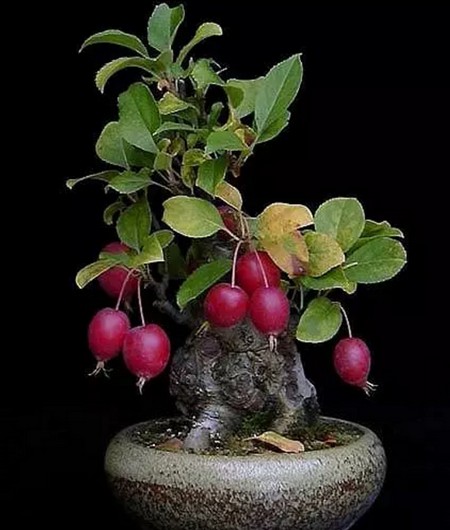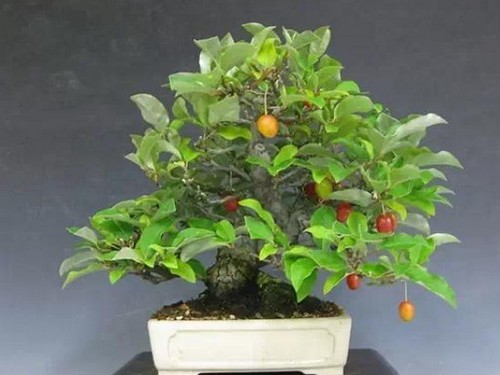Types and characteristics of bonsai buds of fruit trees
In recent years, with the improvement of people's living standards and the continuous improvement of office and living conditions, the beautification of the environment is rich and colorful. Potted fruit trees and bonsai have become a major landscape and fashion for indoor and outdoor greening decoration, such as rooms, balconies, guesthouses, hotels, parks, courtyards and so on.
Generally speaking, potted fruit trees are a kind of cultivation way to plant fruit trees into pots to make them blossom and bear fruit, while bonsai of fruit trees inherit and carry forward the plastic art of Chinese traditional stump bonsai on the basis of potted fruit trees. form a work of art with high ornamental value. They are all a wonderful work in the flower bonsai industry.

Due to the unique beautification effect of potted fruit trees and bonsai, they can be decorated in large hotels and restaurants, and can also be built into air orchards and miniature orchards, which are more loved by flower bonsai lovers. With their unique charm of colorful spring flowers, green summer leaves, colorful autumn fruits and hard winter branches, they are praised by garden experts as a living art that combines "new, strange and wonderful".
All branches, leaves, flowers and fruits are developed from buds, which are the primitive bodies that form these organs. when propagating, the grafted buds can form new plants. There are several types of buds:
According to the place where the bud is planted on the branch, it can be divided into terminal bud and lateral bud. The terminal bud is born at the top of the branch and has a strong germinating power, which can generally germinate in the second year. The lateral bud is born between the branches and leaves, also known as the organ bud, the germination ability is poor, often can not germinate in the second year.
According to the number of buds born on the same node, they can be divided into single buds and multiple buds. Those who have only one bud on a node are called single buds, such as apples, pears and persimmons. A section bearing more than two buds is called compound bud, such as peach, plum, apricot compound bud often has 2-4 buds. In addition, on the side or base of lateral buds such as apple, pear, jujube and Hawthorn, there is a small and difficult to find lateral bud, which is mostly in a state of resting eyes, and can germinate when the main bud is damaged.
According to the nature of the bud, it can be divided into flower bud and leaf bud. Leaf buds can only branch and send leaves, but flower buds can blossom and bear fruit. In the external shape, the flower buds are generally more fat and full, and the bud scales are tighter. Different tree species and varieties have different characteristics of flower buds and lateral buds. Potted plant workers must accurately identify.
Some fruit trees, such as grapes, peaches, apricots, plums and other buds formed in that year can germinate, called early-maturing buds. It can make the branches grow many times and increase the branching order of the whole tree, so the fruit trees with precocious buds generally bear fruit earlier.
Due to the differences in environmental conditions and nutritional status in the process of bud formation and development, the quality, growth potential and shape characteristics of buds are different. For example, the buds at the base of branches are formed in early spring, when the temperature is low and there are few leaves, so the buds formed are shrunken buds with a "ring mark" at the base of the branches. Since then, with the increase of air temperature and leaf area, the quality of buds formed in the middle of branches became better, and the buds were large and full. Similarly, at the junction of the spring and autumn shoots, the buds formed when the autumn shoots just began to grow are not full, which is commonly known as the "Blind Festival".
The quality and plumpness of buds significantly affected the growth potential of new shoots. Full strong buds, big buds produce strong branches and long branches; weak buds and small buds produce weak branches and short branches. In shaping and pruning, this characteristic of buds is often used to change the length of branches and the ratio of long to short branches, so as to promote shaping and early fruiting.
Time: 2019-05-25 Click:
- Prev

Growth characteristics of bonsai leaves of fruit trees
Bonsai fruit trees set to view the shape of trees, enjoy good color, taste fresh fruit in one. Trees need to bear a certain number of fruits, and the shape, distribution, size, number, color and leaf-fruit ratio of fruits are all important factors that constitute the bonsai art of fruit trees. Bonsai of some fruit trees have not only ornamental value, but also edible fruit.
- Next

Cultivation techniques of Elaeagnus angustifolia bonsai
Elaeagnus angustifolia is a kind of bonsai tree with beautiful shape, beautiful leaves, rich flowers and bright fruit. Because its plant is small, it is often used to make medium, small or miniature bonsai. It is displayed on the desk, several shelves, etc., Qiu branch green leaves, plain flowers and red fruits, very beautiful. Spring and March is the most suitable for transplant.
Related
- Fuxing push coffee new agricultural production and marketing class: lack of small-scale processing plants
- Jujube rice field leisure farm deep ploughing Yilan for five years to create a space for organic food and play
- Nongyu Farm-A trial of organic papaya for brave women with advanced technology
- Four points for attention in the prevention and control of diseases and insect pests of edible fungi
- How to add nutrient solution to Edible Fungi
- Is there any good way to control edible fungus mites?
- Open Inoculation Technology of Edible Fungi
- Is there any clever way to use fertilizer for edible fungus in winter?
- What agents are used to kill the pathogens of edible fungi in the mushroom shed?
- Rapid drying of Edible Fungi

